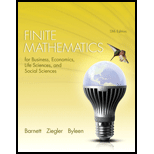
Refer lo Problem 28. Fill in the elements in the following technology matrix.
Use this matrix to solve Problem 28. Discuss any differences in your calculations and in your answers.
Want to see the full answer?
Check out a sample textbook solution
Chapter 4 Solutions
Finite Mathematics for Business, Economics, Life Sciences and Social Sciences Plus NEW MyLab Math with Pearson eText -- Access Card Package (13th Edition)
Additional Math Textbook Solutions
Basic Business Statistics, Student Value Edition
Introductory Statistics
A First Course in Probability (10th Edition)
Calculus: Early Transcendentals (2nd Edition)
Elementary Statistics
Pre-Algebra Student Edition
- Question Given the following piecewise function, evaluate lim →1− f(x). Select the correct answer below: ○ 1 ○ 4 -4 The limit does not exist. -2x² - 2x x 1arrow_forwardSolve the linear system of equations attached using Gaussian elimination (not Gauss-Jordan) and back subsitution. Remember that: A matrix is in row echelon form if Any row that consists only of zeros is at the bottom of the matrix. The first non-zero entry in each other row is 1. This entry is called aleading 1. The leading 1 of each row, after the first row, lies to the right of the leading 1 of the previous row.arrow_forwardSolve the linear system of equations attached using Gaussian elimination (not Gauss-Jordan) and back subsitution. Remember that: A matrix is in row echelon form if Any row that consists only of zeros is at the bottom of the matrix. The first non-zero entry in each other row is 1. This entry is called aleading 1. The leading 1 of each row, after the first row, lies to the right of the leading 1 of the previous row.arrow_forward
- Actividades: malemática (Erigonometria) Razones trigonometrica 2025 23 Jures Encuentra las seis razones of trigonométricas, on los siguienter tiringher rectangulies 4 A C =7 b=8cm. * c C=82m a=? * C * B A 4A=- 4 B= C=12cm B 9=7 C A b=6um B a=6cm Sen&c=- AnxB=- Sen&A = Anx = - Bos *A= - cos &c= Zang KA= Tong&c= ctg & A= — ctg &c= Séc & A = - Cosc&A= Secxce csck(= cos & C = - cos & B= Tong & C = — tang & B = d=g&c= cfg &c=— cg & B= sec &C= secxB=- оскв=- =_csCKB = 6=5m AnxA = - AnxB= cos * A= - cos &b= Tmg & A = - Tong & B=- ct₁ A = - C√ B=- cfg & Soc *A= Sec & B=- ACA=- CAC & B=- FORMATarrow_forwardPRIMERA EVALUACIÓN SUMATIVA 10. Determina la medida de los ángulos in- teriores coloreados en cada poligono. ⚫ Octágono regular A 11. Calcula es número de lados qu poligono regular, si la medida quiera de sus ángulos internos • a=156° A= (-2x+80 2 156 180- 360 0 = 24-360 360=24° • a = 162° 1620-180-360 6=18-360 360=19 2=360= 18 12. Calcula las medida ternos del cuadrilá B X+5 x+10 A X+X+ Sx+6 5x=3 x=30 0 лаб • Cuadrilátero 120° 110° • α = 166° 40' 200=180-360 0 = 26-360 360=20 ひ=360 20 18 J 60° ⚫a=169° 42' 51.43" 169.4143180-340 0 = 10.29 54-360 360 10.2857 2=360 10.2857 @Saarrow_forward(4) (8 points) (a) (2 points) Write down a normal vector n for the plane P given by the equation x+2y+z+4=0. (b) (4 points) Find two vectors v, w in the plane P that are not parallel. (c) (2 points) Using your answers to part (b), write down a parametrization r: R² — R3 of the plane P.arrow_forward
- (2) (8 points) Determine normal vectors for the planes given by the equations x-y+2z = 3 and 2x + z = 3. Then determine a parametrization of the intersection line of the two planes.arrow_forward(3) (6 points) (a) (4 points) Find all vectors u in the yz-plane that have magnitude [u also are at a 45° angle with the vector j = (0, 1,0). = 1 and (b) (2 points) Using the vector u from part (a) that is counterclockwise to j, find an equation of the plane through (0,0,0) that has u as its normal.arrow_forward(1) (4 points) Give a parametrization c: R R³ of the line through the points P = (1,0,-1) and Q = (-2, 0, 1).arrow_forward
- 7. Show that for R sufficiently large, the polynomial P(z) in Example 3, Sec. 5, satisfies the inequality |P(z)| R. Suggestion: Observe that there is a positive number R such that the modulus of each quotient in inequality (9), Sec. 5, is less than |an|/n when |z| > R.arrow_forward9. Establish the identity 1- 1+z+z² + 2n+1 ... +z" = 1- z (z1) and then use it to derive Lagrange's trigonometric identity: 1 1+ cos cos 20 +... + cos no = + 2 sin[(2n+1)0/2] 2 sin(0/2) (0 < 0 < 2л). Suggestion: As for the first identity, write S = 1+z+z² +...+z" and consider the difference S - zS. To derive the second identity, write z = eie in the first one.arrow_forward8. Prove that two nonzero complex numbers z₁ and Z2 have the same moduli if and only if there are complex numbers c₁ and c₂ such that Z₁ = c₁C2 and Z2 = c1c2. Suggestion: Note that (i≤ exp (101+0) exp (01-02) and [see Exercise 2(b)] 2 02 Ꮎ - = = exp(i01) exp(101+0) exp (i 01 - 02 ) = exp(102). i 2 2arrow_forward
- Algebra & Trigonometry with Analytic GeometryAlgebraISBN:9781133382119Author:SwokowskiPublisher:Cengage
 College Algebra (MindTap Course List)AlgebraISBN:9781305652231Author:R. David Gustafson, Jeff HughesPublisher:Cengage Learning
College Algebra (MindTap Course List)AlgebraISBN:9781305652231Author:R. David Gustafson, Jeff HughesPublisher:Cengage Learning Algebra: Structure And Method, Book 1AlgebraISBN:9780395977224Author:Richard G. Brown, Mary P. Dolciani, Robert H. Sorgenfrey, William L. ColePublisher:McDougal Littell
Algebra: Structure And Method, Book 1AlgebraISBN:9780395977224Author:Richard G. Brown, Mary P. Dolciani, Robert H. Sorgenfrey, William L. ColePublisher:McDougal Littell  Linear Algebra: A Modern IntroductionAlgebraISBN:9781285463247Author:David PoolePublisher:Cengage Learning
Linear Algebra: A Modern IntroductionAlgebraISBN:9781285463247Author:David PoolePublisher:Cengage Learning Elementary Linear Algebra (MindTap Course List)AlgebraISBN:9781305658004Author:Ron LarsonPublisher:Cengage Learning
Elementary Linear Algebra (MindTap Course List)AlgebraISBN:9781305658004Author:Ron LarsonPublisher:Cengage Learning





